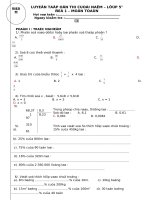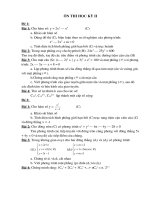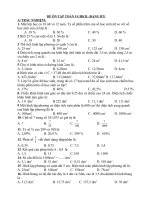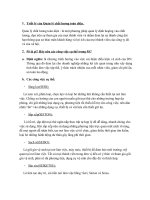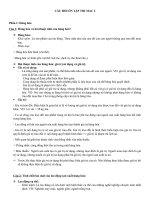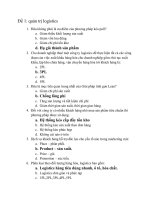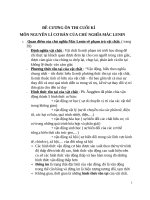Quản trị Logistics đề ôn thi cuối kì
Bạn đang xem bản rút gọn của tài liệu. Xem và tải ngay bản đầy đủ của tài liệu tại đây (3.1 MB, 178 trang )
CHAPTER 1: OVERVIEW LOGISTICS AND SUPPLY CHAIN
1.
“Some companies use suitable mode of transportation with an acceptable cost
to meet customer delivery requirements as well as increase satisfaction for the
customer”. As such, the company could be considered______
a.
Productivity but not effective.
b.
Efficient but not effective.
c.
Effective but not efficient.
d.
Reengineering but not productivity
"Some companies use premium transportation to meet customer delivery
requirements". ( cách hỏi khác)
2.
Which one includes in order processing activity?
a. Negotiate terms and conditions
b. Select suitable material handling equipment
c. Checking the status of orders.
d. Choose the best location for warehouse establishment.
3.
The _____department often measures inventory in terms of its cost or value
in dollars, whereas_______tends to measure inventory in terms of units.
a. production; sales
b. marketing; logistics
c. sales; finance
d. financial ; logistics
4.
The _______approach mentions all relevant cost items are considered
simultaneously when making a decision.
a. interfunctionality
b. total cost
c. systems
d. rhochrematics
5.
The _______approach indicates that a company's objectives can be realized
by recognizing the mutual interdependence of major functional areas.
a. interfunctionality
b. systems
c. rhochrematics
d. supply chain
6.
a.
b.
c.
d.
A cost trade-off is a situation where:
some costs are eliminated by efficient management controls
all costs are reflected as a percentage variation from standard costs.
some costs increase and some costs decrease.
all costs react according to their individual degrees of inflation in the economy.
7.
A cost trade-off is a situation where:
a.
some costs increase and some costs remain constant
b.
all costs are reflected as a percentage variation from standard costs.
c.
The firm accepts for using premium transportation to release more products
in their warehouse.
d.
some costs are eliminated by efficient management controls
8.
________utility refers to the value or usefulness that comes from a customer
being able to take possession of a product.
a. Form
b. Time
c. Place
d. Possession
9.
"How well a company does what it says it's going to do" represents_____
a. leading edge logistics
b. efficiency
c. productivity
d. effectiveness
10.
Logistics costs in Vietnam as a percentage of GDP were estimated at........ in
2020.
a. 8.9%
b. 33.3% 6
c. 16.8%
d. 57.6%
11.
Which does include in warehousing activity?
a. Estimate product demand in the future
b. Select the carrier who can provide lower freight for the firm
c. Use appropriate equipment to load unload the products
d. Basing on featured characteristics of product, the firm' will select the suitable
method to store product.
12.
Which concept refers to the storage of raw materials and movement to the
producer?
a. materials management
b. supply chain management
c. physical distribution
d. inbound logistics
13.
Which of the below does belong to logistics cost?
a. Capital costs
b. costs from procurement activity
c. Labour costs
d. Costs paid for buying machinery
14.
_____refers to an item that the firm holds with a very large amount of
quantity at the same time there is no demand for it.
a.
Overstock
b.
Intensive distribution
c.
Stockout
d.
Tailored logistics
15.
Logistics costs of bubble manufacturing industry will be____compare with
logistics costs of automobile manufacturing industry
a. higher
b. lower
c. not different
d.equal
16.
In transportation activity, how companies can do to increase the satisfaction
of customers?
a. Return goods policy Issuance
b. Design transportation route with very short delivery time.
c. Reply quickly demand for product fixing from customers
d. Question A & C are correct.
17.
In the past, which field does logistics not connect with?
a. cooper
b. army
c. soldiery
d. traveling
18.
Process management occurs from placing order of customers, checking the
status of products, make announcement for customer about availability of product,
packaging the product and delivery the product to customer refers to______
a. Materials Handling
b. Procurement management
c. Warehousing location
d. Order processing
19.
Which of the following mentions to contribution of logistics to place utility?
a. Procter and Gamble of General Mills repackage products during distribulion into special
sizes, sample packs, or multi-packs.
b. Online retailers like Amazon.com and Alibaba.com delivery products directly to
your home or office
c. The firm brings a variety of payment methods for the customer such as by cash, money
transfer, electronic wallet.
d. Four-day late delivery of apples likely has more serious results than a four-day late
delivery of a box of paper
20. Beverages sold in small size presentations are perfects to fit the needs of
consumers that are occasionally thirsty, as opposed to big-size presentation that are
more suitable for family gatherings or group meetings” is considered for the
example of_____
a. possession utility
b. time utility
c. place utility
d. form utility
21. How many modes of transportation?
a. 2
b. 4
c. 3
d. 5
22. Which of the below is the most difficult to control in 7R’s?
a. right quantity
b. right time
c. right place
d. right product
23. Which of the below does not belong to logistics cost?
A. Labour costs
B. Transport costs
C. Inventory costs
D. Storage costs
24. Which concept refers to the storage of the final product and movement to the
customer?
A. materials management
B. supply chain management
C. inbound logistics
D. physical distribution
25. Which of the following mentions to contribution of logistics to time utility?
a. Online retailers like Amazon.com and Alibaba.com delivery products directly to your
home or office.
b. The firm brings a variety of payment methods for the customer such as by cash, money
transfer, electronic wallet.
c. Four-day late delivery of apples likely has more serious results than a four-day late
delivery of a box of paper.
d. Procter and Gamble or General Mills repackage products during distribution into special
sizes, sample packs, or multi-packs.
KAHOOT CHƯƠNG OVERVIEW LOGISTICS AND SUPPLY CHAIN
1.
A.
B.
C.
D.
Logistics clearly contributes to____ and ____ utility.
Time, place
Place, form
Possession, time
Form, time
2.
Which of the following is not a reason for the increased importance of
logistics?
A.
Reduction in economic regulation
B.
Growing power of manufacturers
C.
Technological advance
D.
Globalization of trade
3.
What concept refers to “how well company resources are used to achieve
what a company promises it can do?”
A.
Efficiency
B.
Productivity
C.
Reengineering
D.
Effectiveness
4.
A.
B.
C.
D.
______ are stores with large amounts of both floor space and product for sale
Mass merchandisers
Big-box retailers
Power retailers
Do-it-yourself (DIY) retailers
5.
The four general types of economic utility are production, possession, time
and place
A.
True
B.
False
6.
Logistics is only concerned with forward flows, that is, those directed towards
the points of consumption.
A.
True
B.
False
7.
Transportation represents the costliest logistics activity in many
organizations
A.
True
B.
False
8.
The movement and storage of materials into a firm refers to:
A.
Physical distribution
B.
Materials management
C.
Supply chain management
D.
Materials handling
9.
“Logistics is the function responsible for controlling the flow of materials
from_________”
A.
Supplier to producer, and then out to customer
B.
Producer to customer
C.
Producer to wholesaler and retailer
D.
Supplier to producer
10.
A.
B.
C.
D.
The overall aim of logistics is to:
Achieve high customers satisfaction
High quality service
Acceptable cost
All answers are right
CHAPTER 8: INVENTORY MANAGEMENT
1. Which of the following industries should apply the theory of lean supply chain?
A.
Gasoline in ustry
B.
Technological products
C.
Fashionable goods
D.
Automobile industry
2. Which one of the following statements regarding the Economic Order Quantity
(EOQ) is true?
A.
If an order quantity is smaller than the EOQ, the annual holding cost is higher than
the annual ordering cost.
B.
The EOQ model assumes a variable lead time.
C.
Quantity discounts are possible.
D.
If an order quantity is smaller than the EOQ, the annual holding cost is lower
than the annual ordering cost.
If an item is ordered at its economic order quantity, the annual carrying cost should
be:
A.
equal to the annual ordering cost.
B.
slightly less than the annual ordering cost.
C.
twice the annual purchase price.
D.
the square root of the annual ordering cost.
3. The trade-off that exists between carrying and ordering costs is that they respond
in opposite ways to the number of orders or size of orders. That is, an increase in the
number of orders leads to..............order costs and............carrying costs.
A.
higher; lower
B.
higher; higher
C.
lower; higher
D.
lower; lower
The trade-off that exists between carrying and ordering costs is that they respond in
opposite ways to the number of orders or size of orders. That is, an decrease in the
number of orders leads to............order costs and.............carrying costs.
A.
higher; lower
B.
lower; lower
C.
lower; higher
D.
higher; higher
4. The purchase cost of a widget is $10, and the holding rate is 50% of purchase cost;
cost of processing an order is $25, annual demand is for 400 widgets, and supply
and usage patterns are stable. What is the economic order quantity (EOQ)?
A.
73.45
B.
63.24
C.
33.24
D.
87.62
5. What concept can be viewed as a combination of processes, functions, activities,
relationships, and pathways along which products, services, information, and
financial transactions move in and between enterprises from original producer to
ultimate end user or consumer?
A.
interorganizational coordination
B.
logistics
C.
operations
D.
supply chain
6. All of the following are suggestions for dealing with dead stock (inventory),
except____:
A.
aggressive marketing
B.
donate to charities
C.
throw it away
D.
All answers are correct
8. When demand and delivery lead time are known and constant, and demand is nine
per day, and purchase lead time is four days, the reorder point is:
A.
13
B.
8
C.
32
D.
36
9. Which of the following is the reason that companies hold a supply of inventory?
A.
Companies would like to purchase in bulk to take advantage of quantity
discounts
B.
Companies would like to increase inventory costs
C.
Companies would like to increase production change
D.
Companies would like to increase setup costs
10. There are some of the ways that inventory can be reduced in the supply chain
except from:
A.
the use of premium transportation
B.
smaller, more frequent orders
C.
Supply-push
D.
the elimination or consolidation of slower-moving products
11. Use this information below to calculate the optimal order quantity:
- Annual demand for backpacks is 45,000 units
- The cost to place an order is $250
- The per unit cost of the item is $30.00
- The annual holding rate is 27.5%
A.
1651 units
B.
834 units
C.
920 units
D.
711 units
12. "The wages of the person who takes orders by telephone" is considered
as...............
A.
storage costs
B.
obsolescence costs
C.
shrinkage costs
D.
order costs
13. Which organizational function is not a focus of the Supply Chain Operations
Reference (SCOR) model?
A.
warehousing
B.
logistics
C.
procurement
D.
operations
14. Which of the following is an example of a carrying cost for products purchased
from a supplier?
A.
the cost of pilferage while in storage
B.
the cost associated with processing the invoice
C.
the cost of transmitting the order
D.
the cost of clerical staff for preparing the purchase
Which of the following is an example of an ordering cost for products purchased from
a supplier?
A.
B.
C.
D.
The cost of clerical staff for preparing the purchase
The cost of pierogi while in storage
The cost associated with damaged products due to out of date
The cost of buying insurance
15. Which of the following are characteristics of an agile supply chain?
A.
an organization's ability to respond to changes in demand with respect to
volume and variety.
B.
eliminating all waste, including time, and to ensure a level schedule
C.
an organization's ability to respond to o changes in demand with respect to
quantity and quality.
D.
apply when customer demand is relatively stable and variety is low
16. Dead inventory refers to a product for which there is no sales during a____period.
A.
12 month
B.
9 month
C.
3 month
D.
6 month
17. What is meant by ABC analysis of inventory?
A.
ABC analysis of inventory is o synonymous with vendor-managed inventory
B.
All inventories are not of equal value to a firm and, as a result, all inventory
should not be managed in the same way.
C.
All inventories are equal value to a firm O and, as a result, all inventory should be
managed in the same way.
D.
ABC analysis of inventory is an alternative to the EOQ model.
18. The order of product flow in the supply chain is as follows:
A.
Component manufacturer, raw material supplier, retailer, wholesale distributor,
end product manufacturer, end-product consumer
B.
Raw material supplier, retailer, component manufacturer, wholesale distributor,
end product manufacturer, end-product consumer
C.
Raw material supplier, component manufacturer, end product
manufacturer, wholesale distributor, retailer, end-product consumer
D.
Raw material supplier, component manufacturer, retailer, wholesale distributor,
end product manufacturer, end-product consumer.
19. Which of the following is FALSE?
A.
The boomerang effect refers to variability in demand orders among supply
chain members.
B.
The supply chain concept originated in the logistics literature.
C.
The SCOR model identifies six key processes including plan, source, make,
deliver, return, and enable associated with supply chain management.
D.
Supply chain disruptions (e.g., terrorist attacks, natural disasters) have caused
some supply chains to reassess their emphasis on inventory reduction.
20. Holding low levels of inventory result in ___ inventory carrying costs and some
____ stockout costs.
A.
High, low.
B.
Constant, low.
C.
Low, high.
D.
High, constant.
21. Which of the following is NOT a reason that companies hold a supply of
inventory?
A.
Companies would like to increase inventory costs
B.
Companies would like to get more profit when buying the product at lower price
and selling at higher price
C.
Companies would like to purchase in bulk to take advantage of quantity discounts
D.
Companies would like to meet an increasing demand of customer
22. Which of the following method that the firm can apply to reduce inventory
through the supply chain?
A.
Break orders with smaller quantities, and place frequently
B.
Supply-push
C.
The use of poor transportation
D.
The firm does not deal with slower - moving products
23. Which of the following is FALSE?
A.
The bullwhip effect refers to variability in demand orders among supply chain
members.
B.
Supply chain disruptions (eg, terrorist attacks, natural disasters) have caused some
supply chains to reassess their emphasis on inventory reduction
C.
The supply chain concept originated in the marketing literature.
D.
The SCOR model identifies six key processes including plan, source, make,
deliver, return, and enable associated with supply chain management.
24. The purchase cost of a widget is $8, and the holding rate is 20% of purchase cost;
cost of processing an order is $30, annual demand is for 300 widgets, and supply
and usage patterns are stable. What is the economic order quantity (EOQ)
A.
B.
C.
D.
106.06
87.62
63.24
73.45
KAHOOT CHƯƠNG INVENTORY MANAGEMENT
1.
_________refers to stocks of goods and materials that are maintained for
many purposes.
A.
Inventory
B.
Supply chain management
C.
Logistics
D.
Production
2.
A.
B.
C.
D.
Each of the following is a component of inventory carrying cost except:
Accounting cost
Shrinkage cost
Storage cost
Interest cost
3.
A.
B.
Safety stock is also referred to as cycle stock.
False
True
4.
The higher the average cost of a stockout, the more likely a company is going
to want to hold safety stock.
A.
True
B.
False
5.
The higher the average cost of a stockout, the more likely a company is going
to want to hold safety stock.
A. True
B. False
6. Lean manufacturing focuses on the elimination of waste.
A.
B.
True
False
7. Service parts logistics has decreased in importance in recent years.
A.
B.
False
True
8. __________ products refer to those that customers view as being able to fill the
same need or want as another product.
A.
B.
C.
D.
Substitute
Me-too
Copycat
Co-branded
9. _________stock refers to inventory that is needed to satisfy normal demand during
the course of an order cycle.
A. cycle (base)
B. safety
C. speculative
D. pipeline
10. Holding high levels of inventory result in______ inventory carrying costs and
________stockout costs.
A. high – low.
B. low – low
C. low – high
D. high - high
CHƯƠNG 10 WAREHOUSING
1. What is the biggest advantage of public warehousing?
A. offers users a great deal of control over their storage needs
B. can be constructed to meet user specifications and companies can also control product
placement within a facility.
C. offers access to products when an organization needs or wants them.
D. users can save money because there is no capital investment
2. Which of the following is not one of the common causes of warehousing fires?
A. cutting or welding too close to combustibles
B. heat source too close to combustibles
C. lightning strikes
D. electrical failure or malfunction
3. As aisle space............., the storage capacity of a facility......................
a. decreases; remains constant
b. increase; remains constant
c. increases; decreases
d. remains constant; decreases
4. Which of the following is true?
a. consolidation of several units into smaller units to increase shipping costs
b. the unit load is of limited value to shippers that deal in larger quantities
c. the unit load allows mechanical devices to be replaced for manual labor
d. unit loads may encourage pilferage
5. Which of the following statements is true?
a. clean and sanitary warehousing facilities can increase employee turnover
b. contract warehousing simultaneously mitigates the negative aspects and
accentuates the positive aspects of public and private warehousing.
c. contract warehousing is owned or occupied on a long-term lease by the firm using them
d. assorting refers to separating products into grades and qualities desired by different
target markets.
6. The theft usually takes place in the warehouse that shows poor...............................
a. warehousing safety
b. Warehousing productivity
c. warehousing cleanliness and sanitation
d. warehousing security
7. A major drawback to metal and plastic pallets is their ____.
A. weight
B. lifespan
C. incompatibility with existing forklifts
D. price
8. What's meaning of the following label?
A. keep temperature
B. keep frozen
C. keep freezing
D. keep cold
9. A unit load involves ____.
A. loading an entire vehicle with shipments from three or fewer shippers
B. the usage of a pallet rack system of storage
C. convoy of rail cars carrying the same product
D. consolidation of several units into larger units to improve efficiency in handling
and to reduce shipping costs
10. What's kind of goods that should be stored in cold warehouse?
A. camping equipment
B. Technological devices
C. cement
D. flower
11. Which of the following statements regarding perishable products is true?
A. perishable products require normal packaging as they move from source to customer
B. these goods are not sensitive to time.
C. there is no special requirement for loading goods.
D. they require temperature storage
12. Which of the following is the principle which should be considered by the firm
when loading the fuel drums on the vessel?
A. The firm should place heavy items on fuel drums
B. The firm should place heavy items under fuel drums
C. The firm should use dunnage to fulfill all blank spaces and fix fuel drums in the
container
D. A & C are correct.
13. "Facilities may have walls and doors that can withstand several hours of intense
fire as well as have proper sprinkling systems as well as excellent ventilation". These
are design elements which should be considered when storing............................
A. Automobile
B. hazardous materials
C. Technological goods
D. FMCG products
14. Which of the following is not an example of warehouse automation?
A. radio frequency identification
B. automated guided vehicles
C. carts are pushed/pulled by stevedores.
D. automated storage and retrieval systems
15. What's meaning of the following label?
A. Keep dry
B. Do not drop
C. Hand with care
D. This side up
16. In cross-docking facility, facility should be as...........as possible.
A. capacious
B. larger
C. narrow
D. wider
17. What's following element which requires for consolidated shipping?
A. Destination points of all shipments have to be the same.
B. Characteristics of goods have to be the same.
C. A forwarder will be responsible for collecting shipments from all shippers.
D. All answers are right.
18. The basic unit in unit loading is a ____.
A. container
B. crate
C. pallet
D. box
19. Which of the following statements regarding hazardous products is true?
A. hazardous products should be placed together with foodstuff.
B. no need to install fire protection equipment for warehouse which is used to storage
dangerous goods.
C. chemical drums are piled up as high as possible to maximize storage spacing.
D. users need to install warning boards/signals at the storing area of dangerous goods.
20. Which of the following statements is false?
A. Buildings that store hazardous materials often have walls and doors that can withstand
several hours of intense fire.
B. A one-dock warehouse layout, in contrast to a two-dock layout, increases the space
needed for storage docks.
C. Radio frequency identification is an example of warehouse automation.
D. Narrower aisles can increase the space utilization of a facility.
21. Multiclient warehousing mixes attributes of ____ and ____ warehousing.
A. Common; private
B. Private; contract
C. Public; contract
D. Public; common
22. Which of the following is the advantage of unit load?
A. it enables mechanical devices to be substituted for manual labor.
B. the mechanical devices, such as a forklift, that can be substituted for manual labor can
be very expensive and need to routine maintenance.
C. It represents a larger quantity of an item than a single box and may be of limited value
to organizations that deal in small quantities.
D. a lack of standardization of pallet sizes
23. The Globally Harmonized System of Classification and Labeling of Chemicals
(GHS) was developed by the ____.
A. World Trade Organization
B. United Nations
C. World Bank
D. International Chamber of Commerce
24. Which of the following is not a characteristic of private warehousing?
A. requires capital investment from user
B. good for companies dealing with large volumes of inventory
C. warehouses can be constructed to meet user specifications and companies can also
control product placement within a facility.
D. lack of control by user
25. Which of the following pairs of goods are incompatible when storing in the
warehouse?
A. candy - snack
B. T-shirt - Trousers
C. green bean - fresh potatoes
D. refrigerator - television
26. What organization regulates the packaging of international air shipments?
A. United Nations
B. International Chamber of Commerce
C. International Air Transport Association
D. World Trade Organization
27. Which of the following statements is false?
A. Narrower aisles can increase the space utilization of a facility.
B. Radio frequency identification is an example of warehouse automation.
C. Buildings that store hazardous materials often have walls and doors that can withstand
several hours of intense fire.
D. A one-dock warehouse layout, in contrast to a two-dock layout, increases the space
needed for storage docks.
28. What's the meaning of the following label?
A. Do not stack
B. Use no hooks
C. Maximum stack
D. Do not drop
29. Which of the following pairs of goods are incompatible when storing in the
warehouse?
A. fabric - clothes
B. mangosteen - mango
C. cotton - foam
D. cement - electronic devices
30. What's the meaning of the following label?
(NẾU HÌNH LÀ GẠCH CHÉO 2 THÙNG)
A. Minimum stack
B. Do not drop
C. Maximum stack
D. Do not stack
31. Why are labels important?
A. labels clarify handling requirements for a package, making shipping and handling
dangerous goods a safer process.
B. hazmat labels help carriers determine stowage and segregation on board planes, trucks
and vessels.
C. emergency responders use hazard labels for accident clean-up and potential
evacuations.
D. all answers are correct.
32. ......................packaging tends to be cheaper, more versatile, and more consumerfriendly than.............packaging.
A. mental; glass
B. wooden; mental
C. glass; wooden
D. plastic; paper
33. What's the meaning of the following label?
A. perishable goods inside the carton
B. environmental friendly products
C. hazardous waste for the environment
D. seafood products
34. Which of the following is false?
A. carts and cranes are examples of handling equipment.
B. racks and bins are examples of storage equipment.
C. materials handling refers to the short distance movement that usually takes place within
the confines of a building such as a plant or distribution center and between a building
and a transportation service provider.
D. container is used for transporting the cargo by airway, waterway (including
seaway and inland waterway), railway and roadway.
35. Which of the following is bulk cargo?
A. Machinery
B. Spirits
C. Coal
D. Shampoo
36. Which of the following is a logistical consequence of packaging inefficiency?
A. decreased damage
B. slower materials handling
C. lower storage costs
D. decreased loss
37. Why milk boxes are rectangle?
A.
Milk needs to be refrigerated. Rectangular boxes occupy less shelf space, and less
shelf space is more valuable when that shelf space has to be cooled.
B.
maximize storing space and all boxes can piled up with many layers.
C.
The ability to comfortably hold the rectangle box in one's hand
D.
All answers are correct.
38. Which of the following is dangerous goods?
A.
B.
C.
D.
vinegar
curry powder
paints
monosodium glutamate
39. Which of the following is right when mentioning to compression packaging
testing?
A.
is designed to evaluate how much weight a package can withstand, and is
particularly relevant to those in the distribution chain and those producing the
packaging raw material.
B.
The test can be performed as a single test or as a series of impact tests to evaluate
the packaging's ability to perform in environments with a horizontal impact hazard.
C.
aims to simulate the types of vibrations that packages suffer during handling,
transportation, and shipping.
D.
is a simulation of the falls that a package holding goods may experience during
shipping and handling.
40. All are characteristics of private warehousing, except_______
A.
B.
C.
D.
feasible when demand patterns are irregular
users have a great deal of control
generates high fixed costs for the user
may reduce an organization's flexibility
41. Which of the following is the example of the product's ability to withstand some
elements?
A.
B.
C.
D.
metal pails can be used for the packaging of liquids
ice cream can be exposed to freezing conditions while vaccine cannot.
weight of foam is lighter than steel.
sugar should be packaged in bags.
42. Which of the following pair of goods are incompatible when storing in the
warehouse?
A.
B.
C.
D.
green bean - fresh potatoes
candy - snack O
T-shirt - Trousers
refrigerator - television
KAHOOT CHƯƠNG WAREHOUSING
1.Warehouses emphasize ___ and their primary purpose is to maximize ___.
A.
Rapid movement of product; usage of available storage space.
B.
Rapid movement of product; throughput.
C.
Product storage; usage of available storage space
D.
Product storage; throughput
2. ___ is process where a product is received in a facility and shipped at the earliest
time, without storage.
A.
Just in time
B.
Accumulation
C.
Agglomeration
D.
Cross-docking
3. ___ warehousing is owned or occupied on a long-term lease by the firm using them.
A.
Private
B.
Public
C.
Contract
D.
Multiclient
4. ___ is bringing together similar stocks from different sources.
A.
Accumulating
B.
Assorting
C.
Sorting out
D.
Allocating
5. ___ refer to breaking a homogeneous supply into smaller lots.
A.
Sorting out
B.
Allocating
C.
Accumulating
D.
Assorting
6. What is considered to be the biggest drawback to public warehousing?
A.
High fixed cost to user
B.
Lack of safety regulation
C.
Lack of locational flexibility
D.
Lack of control by the user
7. Throughput refers to ____
A.
Storage capacity of a warehousing facility
B.
Volume through a pipeline
C.
Inventory turnover in a one- month period
D.
Amount of product entering and leaving a facility in a given time period
8. The warehousing function that combines the several small shipments to a specific
market area is ____ .
A.
Break bulk function
B.
Operational function
C.
Stockpiling function
D.
Consolidation function
9. _____ focuses on ensuring products reach the consumers through a network of
distributors, warehouses and retailers.
A.
Supply
B.
Manufacturing
C.
Distribution
D.
Inventory
10. Distribution centres emphasize ___ and their primary purpose is to maximize ___
.
A.
Rapid movement of product; throughput
B.
Product storage; throughput
C.
Product storage; usage of available storage space
D.
Rapid movement of product; usage of available storage space
KAHOOT CHƯƠNG 11 PACKAGING
1.
__________ is the science, art and technology of enclosing or protecting
products for distribution, storage, sale and use.
A.
Logistics
B.
Packaging
C.
Warehousing
D.
Inventory
2.
A.
B.
C.
D.
Which of the following is the wrong definition of TEU?
TEU stands for Twenty-foot Equivalent Unit
40ft long container measure 2TEUs
It is method of calculating vessel load or capacity
TEU is also understood as ton
3.
Which of the given reasons is NOT a valid reason for packaging of food
items?
A.
Security and portion control
B.
Marketing and convenience
C.
Protection and information transmission
D.
Increase the weight of goods
4.
A.
B.
C.
D.
What of the following is false?
Package labeling is usually done at the end of the assembly line
Labeling regulations may differ from country to country
Pictures are preferable to words for labeling a product
Labeling requirements may differ from state to state
5.
Each of the following is a shipping hazard that a package may be exposed to
except
A.
Retraction
B.
Vibration
C.
Rough handling
D.
Compression
6.
A.
B.
C.
D.
What is dunnage?
Material is used to block and brace products inside carrier equipment
A slang term for a particular type of ocean liner
A type of packaging material that is placed inside of boxes
Additional transportation fees that are charged to small shippers
7.
________ are required when a continuous flow of material/product operating
over a long period
A.
Conveyors
B.
Pallets
C.
Forklifts
D.
Containers
8.
A.
B.
C.
D.
Package on the pallets can be moved using_______
A lorry
A forklift
A van
Conveyors
9.
A.
B.
C.
D.
The vast majority of pallets are made of__________
Wood
Fiberboard
Plastic
Metal
10.
A.
B.
C.
D.
Which one of the following is NOT classified as a manual handling activity?
Throwing
Pushing
Carrying
Pulling
11.
Conveyor belts facilitate continuous movement of material over a……….
route.
A.
Fixed
B.
Safe
C.
Rotational
D.
Flexible
12.
The major advantage of the unit load is that it enables mechanical devices to
be substituted for manual labor.
A.
True
B.
False
13.
A.
B.
C.
D.
Product destiny refers to a product’s
Weight per volume
Weight
Volume
Fregility
14.
________refers to materials used for the containment, protection, handling,
delivery, and presentation of goods.
A.
Packaging
B.
Procurement
C.
Materials handling
D.
Materials management
15.
_________refers to the short distance movement that takes place within a
plant, distribution or warehouse.
A.
Materials handling
B.
Physical distribution
C.
Materials management
D.
Warehousing
KAHOOT CHƯƠNG 12 TRANSPORTATION
1. _________is generally the fastest form of transportation for shipments exceeding
600 miles.
A.
Air
B.
Less – than – truckload motor carriers
C.
Parcel carriers
D.
Truckingload motor carriers
2. Consignees are_______
A. receivers of freight
B. extremely large less-than-truckload carriers
C. shippers of freight
D. preferred suppliers
3. Which of the following is not likely to move by air transportation?
A. wind power propeller
B. wearing apparel
C. cut flowers
D. fruits and vegetables
4. The primary advantage for motor carriers is_______
A. flexibility (linh hoạt)
B. reliability
C. speed
D. capability
5. ________is the most reliable (đáng tin cậy) form of transportation.
A. pipeline
B. rail
C. motor carriers
D. air
6. ___________ pipelines carry crude oil from gathering-line concentration points to
the oil refineries.
A. trunk
B. product
C. arterial
D. collection
7. _________ _have a level of market concentration and dominance that is not found
in the other modes.
A. railroads
B. pipelines
C. airlines
D. motor carriers
8. What container size is often used to rank water ports and measure containership
capacity?
A. 20 foot container
B. 48 foot container
C. 40 foot container
D. 10 foot container
9. Shipper’s associations________
A. function in a manner similar to freight forwarders
B. are the same as a freight forwarder
C. specialize in truckload shipments
D. are used only for agricultural products
10.
A.
B.
C.
D.
A transportation broker_______
looks to match a shipper's freight with a carrier to transport it
is the same as a freight forwarder
deals only with agricultural products
tends to be spun off from carriers or management consulting firms
